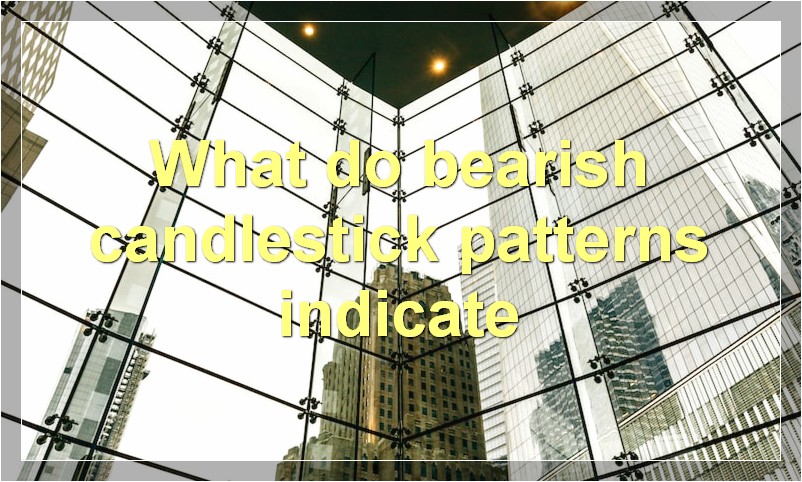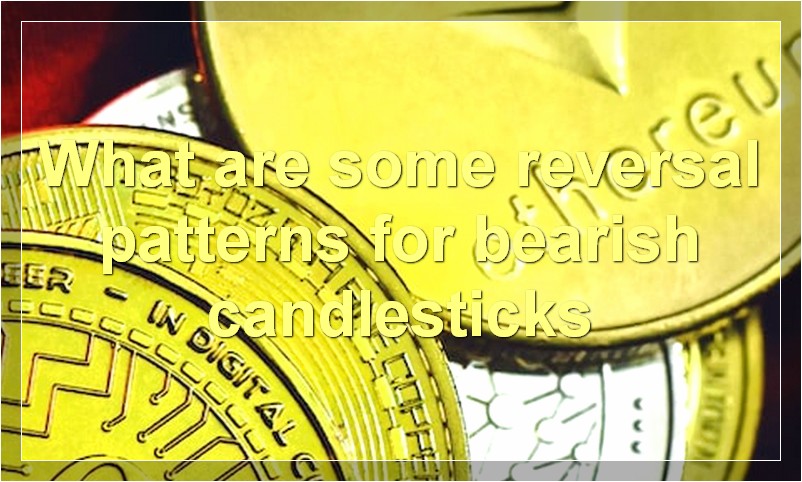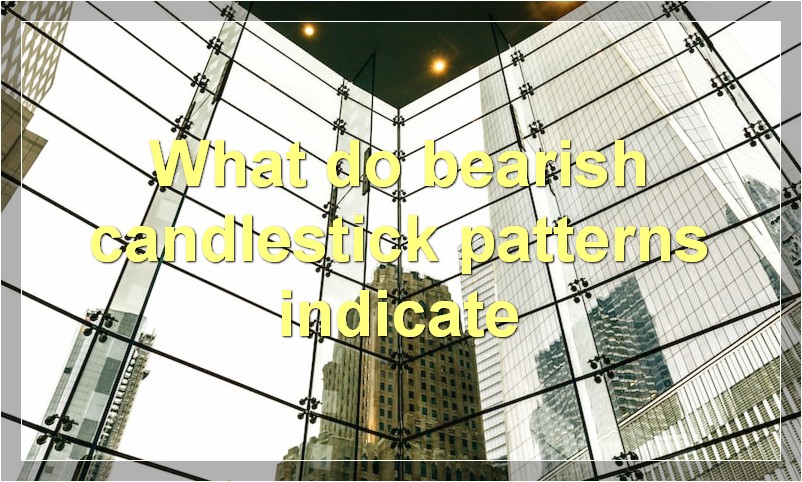A bearish candlestick pattern is a type of candlestick formation that typically happens at the top of an uptrend. These patterns can be used to signal a potential reversal in the market.
What are some bearish candlestick patterns
Candlestick patterns are one of the most important tools that traders use to analyze price action. There are many different candlestick patterns, but some of the most important ones are bearish candlestick patterns.
Bearish candlestick patterns typically form when there is a change in market sentiment from bullish to bearish. This can happen for a variety of reasons, but it often happens when there is bad news about a company or the overall market.
Some of the most important bearish candlestick patterns include the bearish engulfing pattern, the dark cloud cover pattern, and the evening star pattern. These patterns can give traders a good idea of when to sell or short a stock.
While bearish candlestick patterns can be very useful, it’s important to remember that they are just one tool in a trader’s toolbox. Price action can be very complex, and no single indicator is perfect. It’s important to use multiple indicators and to do your own research before making any trading decisions.
What do bearish candlestick patterns indicate

Most candlestick patterns are bullish, meaning they indicate a potential increase in price. Bearish candlestick patterns, on the other hand, indicate a potential decrease in price.
There are several bearish candlestick patterns that traders watch for, including:
The bearish engulfing pattern, which consists of a large red candle that completely engulfs a small green candle. This pattern indicates that the bears are in control and that prices are likely to continue falling.
The dark cloud cover pattern, which consists of a small green candle followed by a large red candle. This pattern indicates that the bulls are losing control and that prices are likely to continue falling.
The bearish harami pattern, which consists of a small green candle followed by a large red candle. This pattern indicates that the bears are gaining control and that prices are likely to continue falling.
These are just some of the more common bearish candlestick patterns. There are many others, but these three are among the most reliable in terms of predicting future price movements.
How can you identify bearish candlestick patterns
When it comes to bearish candlestick patterns, there are a few things you can look for to identify them. First, you want to look for patterns where the open is higher than the close. This is because when the market is bearish, prices tend to close lower than they open. Second, you want to look for patterns where the candlesticks are short and fat. This is because when the market is bearish, trading activity tends to be low and prices tend to be volatile. Finally, you want to look for patterns where the candlesticks are clustered together. This is because when the market is bearish, prices tend to move in a tight range.
What is the difference between bearish and bullish candlesticks
Bearish candlesticks indicate that the market is bearish, while bullish candlesticks indicate that the market is bullish.
What are some common bearish candlestick patterns
There are numerous bearish candlestick patterns, each with its own unique characteristics. However, some patterns are more common than others.
One of the most common bearish candlestick patterns is the engulfing pattern. This pattern occurs when a small bullish candlestick is followed by a large bearish candlestick. The large bearish candlestick “engulfs” the small bullish candlestick, indicating strong selling pressure.
Another common bearish candlestick pattern is the shooting star. This pattern forms when a small bearish candlestick is followed by a large bullish candlestick. The large bullish candlestick then reverses course and closes near its lows, forming a “shooting star” shape. This pattern indicates that buyers were initially in control but were quickly overwhelmed by selling pressure.
The bearish harami is another common pattern. This pattern forms when a large bullish candlestick is followed by a small bearish candlestick. The small bearish candlestick is “nested” within the body of the large bullish candlestick, indicating a potential reversal from bullish to bearish momentum.
Doji candles are often considered to be important reversal indicators. A doji candle occurs when the open and close price are virtually equal. This creates a small “cross” or “plus” sign on the candlestick chart. Doji candles can occur at the top or bottom of a trend, and their appearance often signals that the current trend may be coming to an end.
Finally, the dark cloud cover is another fairly common bearish reversal pattern. This pattern forms when a large bullish candlestick is followed by a large bearish candlestick. The second bearish candle should open above the high of the first bullish candle and then close below its midpoint. This deep penetration into bullish territory indicates significant selling pressure and a potential reversal from bullish to bearish momentum.
What are some reversal patterns for bearish candlesticks

Candlestick reversal patterns are one of the most important tools that traders use to predict future price movements. There are many different candlestick patterns, but some of the most reliable reversal patterns include the bearish engulfing pattern, the dark cloud cover pattern, and the evening star pattern.
The bearish engulfing pattern is a two-candlestick pattern that signals a potential reversal from an uptrend to a downtrend. The first candlestick in the pattern is typically a small white candlestick that is followed by a large black candlestick that completely engulfs the small white candlestick. This pattern indicates that bears are in control and that prices are likely to continue moving lower.
The dark cloud cover pattern is another two-candlestick reversal pattern that signals a potential trend change from up to down. This pattern is similar to the bearish engulfing pattern, but the second candlestick only partially covers the first candlestick. This indicates that there is still some buying pressure present and that prices could move higher before eventually moving lower.
The evening star pattern is a three-candlestick reversal pattern that signals a potential trend change from up to down. The first candlestick in the pattern is a tall white candlestick followed by a small black or red candlestick. The third candlestick is another tall black or red candlestick that completes the reversal. This pattern indicates that bears are starting to take control and that prices are likely to move lower in the near future.
How can you use bearish candlestick patterns to your advantage
Candlestick patterns are a great way to analyze the market and make informed trading decisions. There are many different candlestick patterns, but bearish candlestick patterns are especially useful for spotting potential market reversals.
Some of the most common bearish candlestick patterns include the bearish engulfing pattern, the bearish harami pattern, and the bearish Tweezer Top pattern. Each of these patterns has a specific set of characteristics that can help you identify it on a chart.
Once you know how to spot a bearish candlestick pattern, you can use it to your advantage by taking a short position in the market. This means that you will profit if the price of the asset falls.
Bearish candlestick patterns are just one tool that you can use to trade the markets successfully. Combine them with other technical indicators and market analysis techniques to give yourself an edge over other traders.
What are some things to look for when trading with bearish candlesticks
When a candlestick is bearish, it means that the prices closed lower than they opened. This is generally indicative of selling pressure in the market. There are a few things to look for when trading with bearish candlesticks:
-The candlestick should have a long body. This means that there was significant selling pressure during the period that the candlestick represents.
-The candlestick should have a small or nonexistent wick. This means that the sellers were able to push the prices lower without much resistance from buyers.
-The candlestick should close near the low of the period. This means that the selling pressure was consistent throughout the period.
What are some common mistakes made with bearish candlesticks
There are a few common mistakes that investors make when it comes to bearish candlesticks. One mistake is failing to recognize the difference between a bearish engulfing pattern and a bearish harami. Both of these patterns can indicate a potential reversal, but the bearish engulfing pattern is generally more reliable.
Another mistake is not paying attention to the context of the candlestick pattern. For example, a bearish candlestick pattern may be less significant if it occurs after a long period of bullishness. Similarly, a bearish candlestick pattern may be more significant if it occurs in the middle of a downtrend.
Finally, some investors believe that all bearish candlestick patterns are created equal. This is simply not the case. Some patterns are more reliable than others, and it is important to research each pattern before making any trading decisions.
What are some tips for trading with bearish candlesticks
If you’re looking to trade with bearish candlesticks, here are a few tips to keep in mind. First, it’s important to identify the trend. Is the overall market trend bearish? If so, then you want to look for bearish candlesticks that form during pullbacks. These can be used as entry points for short positions. Second, pay attention to the context. What’s happening around the bearish candlestick? Is there support nearby or is the market oversold? These factors can affect the validity of the candlestick pattern. Finally, don’t get too caught up in the details. Bearish candlesticks come in many different shapes and sizes, so don’t get too hung up on finding the perfect pattern. As long as you’re identifying potential bearish reversals, you’re on the right track.

